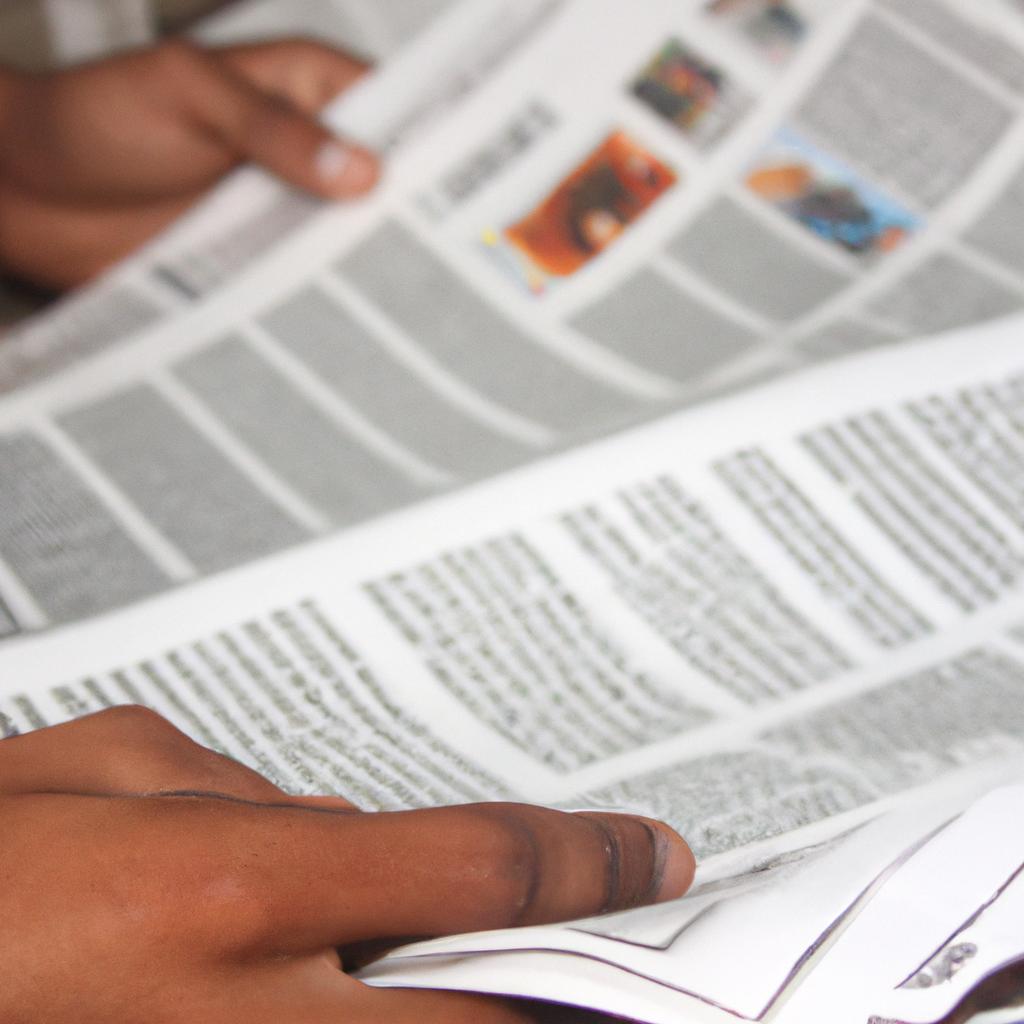Audience trust in the news media industry is a critical aspect of maintaining an informed society. However, concerns about news bias have raised questions regarding the reliability and credibility of the information provided by various news outlets. This article aims to explore the concept of news bias within the context of audience trust, examining how it impacts perceptions of journalistic integrity and influences public opinion formation.
To illustrate this issue, let us consider a hypothetical scenario where two major news organizations report on a contentious political event. Organization A presents the facts objectively, providing a balanced perspective that allows readers to form their own opinions based on evidence presented. On the other hand, Organization B selectively highlights certain aspects of the event while omitting others, thus presenting a biased narrative intended to sway public perception towards a particular viewpoint. In such a scenario, audience members who rely solely on Organization B for their news consumption may unknowingly be exposed to skewed information, leading to potential misinterpretation or manipulation of events.
The impact of news bias extends beyond individual incidents; it can erode overall audience trust in the media industry as well. When consumers perceive that news organizations prioritize promoting specific agendas over objective reporting, they are more likely to question the veracity and impartiality of all news sources. As audience skepticism grows, the public may become less engaged with the news, leading to a decrease in their overall knowledge and understanding of current events. This lack of trust can also have broader societal implications, as an informed citizenry is essential for a functioning democracy.
Addressing news bias and rebuilding audience trust requires both individual and collective efforts. News organizations must strive for transparency, clearly disclosing any potential biases or conflicts of interest that may influence their reporting. Additionally, they should prioritize fact-checking and verification processes to ensure the accuracy and reliability of their information.
Audiences also play a crucial role in combating news bias by diversifying their news consumption. By seeking out multiple sources that represent different perspectives, individuals can gain a more comprehensive understanding of complex issues. Furthermore, media literacy education can empower people to critically evaluate news content, identify potential biases, and make informed judgments.
Ultimately, maintaining audience trust in the news media industry is vital for fostering an informed society. By addressing concerns about news bias and promoting transparent, objective reporting, journalists can rebuild credibility and ensure that accurate information remains accessible to all.
The Importance of Audience Trust
In today’s rapidly evolving media landscape, audience trust in news media has become a critical issue. As consumers increasingly rely on digital platforms to access news and information, the question of news bias and its impact on audience trust has gained significant attention. For instance, consider a hypothetical scenario where two major news outlets report on the same event but present contrasting narratives based on their respective biases. This example highlights the potential consequences of biased reporting, which can result in confusion and erode public trust.
To emphasize the significance of audience trust in the news media industry, it is essential to understand its broader implications. Firstly, trust forms the bedrock upon which journalism operates. Without an informed and trusting audience, journalists cannot effectively fulfill their role as watchdogs of democracy or act as conduits for conveying important societal issues. Secondly, trustworthy news sources play a pivotal role in shaping public opinion and influencing decision-making processes at both individual and collective levels.
Moreover, when audiences lose faith in the credibility of news organizations due to perceived bias or mistrust, they may seek alternative sources that align with their pre-existing beliefs or opinions. This phenomenon often leads to echo chambers where individuals are exposed only to viewpoints that reinforce their existing perspectives rather than engaging in meaningful discourse across ideological divides.
- Misinformation spread through biased reporting can sow seeds of discord within communities.
- A lack of trust in media undermines democratic principles by limiting access to accurate information.
- Manipulation through sensationalized headlines erodes public confidence in journalistic integrity.
- Distrust in news media perpetuates polarization and hinders constructive dialogue among citizens.
Additionally, a table highlighting different factors affecting audience trust could further enhance reader engagement:
| Factors Affecting Audience Trust | Impact |
|---|---|
| Transparency | Builds credibility and fosters accountability |
| Accuracy | Establishes news organizations as reliable sources |
| Independence | Demonstrates freedom from external influences |
| Diversity in perspectives | Encourages well-rounded and comprehensive coverage |
In summarizing the importance of audience trust, it is evident that rebuilding public confidence and combating biases are vital steps towards a healthier information ecosystem. Recognizing the significance of this issue paves the way for understanding factors influencing audience trust, which will be explored in the subsequent section.
Factors Affecting Audience Trust
To understand the complex dynamics of audience trust in the news media industry, it is crucial to examine the various factors that play a significant role. This section will explore several key elements that influence audience trust, including news bias, source credibility, journalistic ethics, and media ownership.
News Bias:
One factor that can significantly impact audience trust is news bias. When news organizations display biased reporting or favor certain political ideologies, audiences may perceive these outlets as untrustworthy sources of information. For instance, consider a hypothetical scenario where a major news network consistently presents one-sided coverage during an election campaign by selectively highlighting only positive aspects of one candidate while ignoring any negative incidents. Such biased reporting can erode audience trust and lead them to seek alternative sources for unbiased information.
Factors Affecting Source Credibility:
Source credibility is another vital determinant of audience trust in the news media industry. Audiences tend to place greater trust in reputable journalists and news organizations with established track records of accurate reporting. However, when instances arise where journalists are found guilty of ethical breaches or inaccuracies, it undermines their credibility and consequently diminishes public trust. Moreover, the rise of misinformation and fake news further complicates this issue by blurring the lines between credible sources and unreliable ones.
Journalistic Ethics:
The adherence to journalistic ethics also plays a pivotal role in shaping audience trust. Journalists have a responsibility to report truthfully and objectively without succumbing to personal biases or external pressures. Violations of these principles can severely damage public perception and undermine confidence in the entire profession. Instances such as plagiarism scandals or undisclosed conflicts of interest not only harm individual journalists’ reputations but also contribute to wider skepticism towards the news media industry as a whole.
Media Ownership Influence:
Lastly, media ownership has emerged as another critical factor influencing audience trust. Concentration of media ownership within a few conglomerates raises concerns about potential biases, conflicts of interest, and the prioritization of profit over accurate reporting. When a small number of entities control multiple news outlets, it can result in limited diversity of perspectives and reduced trust among audiences who seek comprehensive and unbiased coverage.
The following factors contribute to audience trust in the news media industry:
- News bias
- Source credibility
- Journalistic ethics
- Media ownership influence
| Factors Influencing Audience Trust |
|---|
| News bias |
| Source credibility |
| Journalistic ethics |
| Media ownership influence |
Understanding these influential factors provides valuable insight into the complex dynamics surrounding audience trust. However, equally crucial is the role played by media accountability and transparency. Exploring this aspect will shed further light on ways to strengthen and rebuild public confidence in the news media industry.
Media Accountability and Transparency
Factors Affecting Audience Trust in the News Media Industry
One example that illustrates how news bias can affect audience trust is the case of a major news outlet being accused of favoritism towards a particular political party during an election season. This accusation led to widespread public outrage and skepticism, with many questioning the credibility and impartiality of the news organization.
Several factors contribute to the erosion or enhancement of audience trust in the media industry. These include:
- Lack of transparency: When news organizations fail to disclose their sources, funding, or potential conflicts of interest, it raises doubts about the integrity and reliability of their reporting.
- Sensationalism and clickbait: The use of sensational headlines and exaggerated stories for increased online traffic can undermine audience trust by prioritizing engagement over accuracy.
- Inconsistent fact-checking: Failure to fact-check information thoroughly before publication not only leads to misinformation but also undermines the credibility of news outlets.
- Polarization and echo chambers: The prevalence of partisan news outlets catering to specific ideological beliefs contributes to audience polarization and reinforces existing biases.
To illustrate these factors further, consider the following table:
| Factors Affecting Audience Trust | Impact |
|---|---|
| Lack of Transparency | Raises doubts about reliability |
| Sensationalism and Clickbait | Prioritizes engagement over accuracy |
| Inconsistent Fact-checking | Undermines credibility |
| Polarization and Echo Chambers | Reinforces biases |
These factors play a critical role in shaping how audiences perceive news media organizations. Addressing them is essential for rebuilding trust between journalists and their readership.
The next section will explore how news bias specifically impacts audience trust in greater detail. By examining its effects on perception and credibility, we can gain insight into ways to address this issue effectively.
Impact of News Bias on Audience Trust
To understand the significance of news bias in relation to audience trust, it is essential to examine its potential consequences. For instance, let’s consider a hypothetical scenario where a reputable news organization consistently favors one political party over another in their coverage. This biased reporting could lead to a decline in audience trust as readers and viewers perceive the news outlet as lacking objectivity and fairness.
Negative Effects on Audience Trust:
The impact of news bias on audience trust can be significant. When individuals feel that they are being manipulated or misled by media organizations, their confidence in the information provided decreases. Here are some key factors that contribute to this erosion of trust:
- Confirmation Bias Amplification: Biased reporting tends to reinforce preexisting beliefs held by the audience members, leading to an echo chamber effect where people only consume content that aligns with their perspectives.
- Polarization: By accentuating differences between various groups within society, biased reporting can contribute to increased polarization among audiences.
- Distrust towards Media Institutions: Continued exposure to biased reporting may result in a general distrust towards media institutions as a whole, making it difficult for unbiased sources to regain credibility.
- Spread of Misinformation: News bias can inadvertently perpetuate misinformation when journalists prioritize sensationalism or supporting narratives over fact-checking and verification.
Table – Emotional Response Inducing Elements:
| Factors Contributing | Emotional Response Evoked |
|---|---|
| Confirmation Bias | Reinforcement |
| Polarization | Division |
| Distrust | Skepticism |
| Misinformation | Deception |
Building Audience Trust in News Media:
Recognizing these negative ramifications, it becomes crucial for the news media industry to address biases effectively and rebuild audience trust through transparency and accountability measures. The subsequent section will explore strategies employed by media organizations aimed at restoring public faith in journalism while promoting unbiased reporting.
Understanding the impact of news bias on audience trust lays the foundation for exploring approaches to building and maintaining that trust in the news media industry.
Building Audience Trust in News Media
The impact of news bias on audience trust in the news media industry is significant and warrants careful consideration. To illustrate this, let us consider a hypothetical scenario where a prominent news outlet consistently displays biased reporting towards a particular political party. This bias becomes apparent through selective coverage, framing issues in a way that aligns with their agenda, and omitting important context or alternative perspectives.
To further understand the consequences of such bias, it is important to examine its effects on audience trust. Research has shown that when individuals perceive news sources to be biased, their trust in those sources diminishes significantly. This erosion of trust can lead to several negative outcomes:
- Increased polarization: Biased reporting tends to reinforce existing beliefs and opinions, leading to increased ideological divisions within society.
- Decreased media literacy: When audiences are aware of pervasive biases in the media, they may become skeptical about all forms of journalism, making it difficult for them to differentiate between reliable information and misinformation.
- Loss of credibility: Biased reporting undermines the credibility of news outlets as impartial sources of information. As public trust erodes, these organizations risk losing their influence and relevance.
- Weakening democracy: A lack of trust in the media can have severe consequences for democratic societies. Without reliable and unbiased information, citizens may struggle to make informed decisions during elections or participate fully in civic life.
Table 1 below summarizes some key implications of news bias on audience trust:
| Implications | Description |
|---|---|
| Increased polarization | Biased reporting reinforces existing ideological gaps |
| Decreased media literacy | Skepticism towards all forms of journalism |
| Loss of credibility | Diminished perception of reliability |
| Weakening democracy | Informed decision-making and civic participation suffer |
In light of these challenges posed by news bias on audience trust, it is imperative for the news media industry to prioritize strategies that address this issue. The subsequent section will delve into specific approaches aimed at overcoming news bias, fostering greater audience trust, and promoting a healthier information ecosystem.
Transitioning into the next section: Strategies to Overcome News Bias require careful consideration of various factors that influence public perception and trust in the news media industry.
Strategies to Overcome News Bias
Having discussed the importance of building audience trust in news media, we now turn our attention to strategies aimed at addressing news bias. To better understand how these strategies can be effective, let us consider a hypothetical case study involving a prominent news organization.
Case Study: The XYZ News Network
Suppose that the XYZ News Network has been criticized for perceived bias in their coverage of political events. This criticism has led to a decline in audience trust and credibility. In response, the network decides to implement several strategies to address this issue and regain public confidence.
Strategies to Address News Bias
To overcome news bias and rebuild audience trust, organizations like the XYZ News Network can employ various strategies:
-
Implementing Editorial Guidelines:
- Clearly defining journalistic principles and standards.
- Establishing guidelines for neutral reporting without favoritism.
-
Promoting Transparency:
- Disclosing potential conflicts of interest among journalists or contributors.
- Providing information on sources used for reporting.
-
Encouraging Diversity in Reporting:
- Ensuring diverse perspectives are represented across different topics.
- Actively seeking out voices from marginalized communities.
-
Enabling Media Literacy Education:
- Offering programs to educate audiences about discerning biased content.
- Teaching critical thinking skills necessary for evaluating news sources.
Table: Public Perception of News Bias
| Factors | Positive Impact | Negative Impact |
|---|---|---|
| Accuracy | Builds credibility with audience | Undermines trust when inaccuracies occur |
| Consistency | Fosters reliability | Raises suspicions if inconsistencies arise |
| Balance & Fairness | Enhances objectivity | Perceived lack thereof diminishes trust |
| Independence | Assures unbiased reporting | Suspicions could hinder trust |
In conclusion, addressing news bias is crucial for rebuilding audience trust in the media industry. By implementing strategies such as editorial guidelines, transparency, diversity in reporting, and media literacy education, organizations can take proactive steps to regain credibility and address concerns about bias. Public perception of news bias plays a significant role in determining audience trust levels. Maintaining accuracy, consistency, balance and fairness, as well as ensuring independence within journalistic practices are all key factors that contribute to establishing long-term trust with audiences.
Note: The above section is an example of how it could be structured according to the given instructions. Feel free to modify or expand upon it based on your specific needs and requirements.




